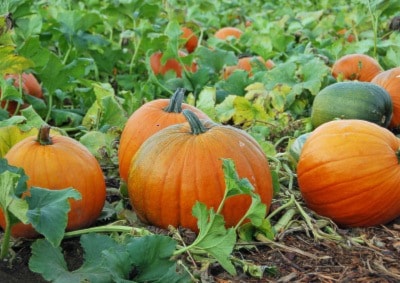Pumpkins are often a child's first introduction to horticulture, and from their early history in the Americas to their future in space gardening research, they deserve a little more credit than just being a jack-o'-lantern.
All pumpkins are indigenous to America and were grown along with corn by native Americans, making them one of the first companion crops. Members of the cucurbitaceae family, their close relatives are watermelon, gourds, squash and cantaloupe.
Recently a flurry of new pumpkin varieties has been developed. A bush-type variety, called Spirit, which has vines that only spread about three feet, delights pumpkin growers with limited space. It is prolific, much like a zucchini, and harvesting a dozen or more 10- to 15-pound fruits is not uncommon.
For more adventurous growers, there are various strains of the Atlantic Giant available. They are bred for size. The winning entries in the World Pumpkin Confederation Weigh Off now exceed 1,200 pounds. You would need a chainsaw to carve these monsters and a shovel and wheelbarrow to clean them out. They also look ugly.
A much nicer giant is Prizewinner, which averages 90 to 100 pounds and actually looks like a pumpkin.
On the sweeter side, smaller is better. Sugar or pie pumpkins are the traditional varieties for pies. Grown from seed stock imported from China, Stokes Seeds Canada has introduced a series of small varieties like Sweetie Pie. Considered a delicacy in China, these miniature pumpkins fit nicely in the palm of your hand. They average only five ounces in weight, measure about three inches across and about one-inch deep – real giants. They are very attractive because of their deep ribbing and can be dried like gourds for neat table decorations. A white and orange striped variety, called Pumkemon, and a white one, called Baby Boo, cook up nicely too.
White pumpkins are all the rage this year, and varieties like Lumina are all over websites like Pinterest as the latest and greatest. Flat ribbed varieties, like Cinderella, are hot too and very unique and different.
Little Lantern, School Time and Orange Smoothie will be of interest to young pumpkin growers. They only measure five to seven inches across, but they really produce lots of little, five to eight pound fruits in eight weeks. They make great pies too.
Pumpkin seeds, which are very high in vitamins, are a delicacy in the Middle East. With the development of two new varieties, Tricky Jack and Lady Godiva, there are now hull-less seeds, which can be eaten like peanuts when lightly roasted. From Japan comes a new edible seed variety called Kakai. It’s awesome, and its fresh seeds are sweet and nut-like.
We all know about those scrumptious pumpkin pies. Another delicious pumpkin dish is made by baking or steaming pumpkin meat, then seasoning it with butter, salt, pepper and molasses. Pumpkin bread and pumpkin cookies stuffed with raisins are popular favourites. In the Caribbean Islands, one of the staple foods is pumpkin soup.
The Land Pavilion in Epcot Centre at Disneyworld, Florida, is experimenting with pumpkins as a food source for space expeditions. Trained upward along ropes, the vines grow about 30 feet high and are loaded with perfect 10- to-15 pound pumpkins.
It is nice to think that the jack-o'-lantern we carve on Halloween to keep the evil spirits away has a great history and an even brighter future. Let's hear it for pumpkins!
Brian Minter is a master gardener who operates Minter Gardens in Chilliwack.
